Rachmaninoff’s Piano Concerto No. 2‚ particularly its second movement‚ is a beloved masterpiece. Its sheet music in PDF format is widely available for download‚ both free and paid‚ offering versatile arrangements for piano solo and orchestral reductions. This concerto’s enduring popularity stems from its emotional depth and melodic richness‚ making it a favorite among pianists and audiences alike.
1.1. Overview of the Concerto
Rachmaninoff’s Piano Concerto No. 2‚ composed in 1900-1901‚ is a monumental work in three movements: Moderato‚ Adagio sostenuto‚ and Allegro scherzando. It is written in C minor‚ with the second movement in E major‚ showcasing the composer’s mastery of melody and harmonic complexity. The concerto is renowned for its emotional depth‚ technical challenges‚ and orchestral richness. As a cornerstone of the piano repertoire‚ it reflects Rachmaninoff’s personal struggles and artistic triumphs. The concerto’s enduring appeal lies in its balance of virtuosic demands and profound expressiveness‚ making it a favorite among pianists and audiences worldwide. Its sheet music‚ particularly the second movement‚ is widely sought after for study and performance.
1.2. Significance of the Second Movement
The second movement‚ Adagio sostenuto‚ is a lyrical and deeply emotional core of Rachmaninoff’s Piano Concerto No. 2. Its haunting melodies and harmonic richness evoke profound feelings‚ making it a standout piece. This movement is often praised for its thematic coherence and expressive qualities‚ showcasing Rachmaninoff’s ability to blend technical brilliance with heartfelt emotion. The sheet music for this movement is highly sought after by pianists‚ as it offers a rewarding challenge and an opportunity to connect with the composer’s inner world. Its popularity endures‚ with arrangements available for solo piano and orchestral reductions‚ ensuring its accessibility to a wide range of musicians.
1.3. Why Seek Sheet Music for the Second Movement?
Pianists and music enthusiasts seek sheet music for Rachmaninoff’s second movement due to its timeless beauty and technical appeal. The Adagio sostenuto offers a profound emotional journey‚ making it a cornerstone of classical repertoire. Musicians desire accurate and accessible arrangements to master its intricate melodies and harmonies. With both free and paid options available‚ pianists can choose formats that suit their skill levels‚ from beginner-friendly scores to advanced editions. Additionally‚ digital sheet music provides convenience‚ allowing instant downloads and transposable versions. This accessibility ensures that Rachmaninoff’s masterpiece remains within reach for aspiring and seasoned pianists alike‚ fostering a deeper connection with the composer’s artistry.
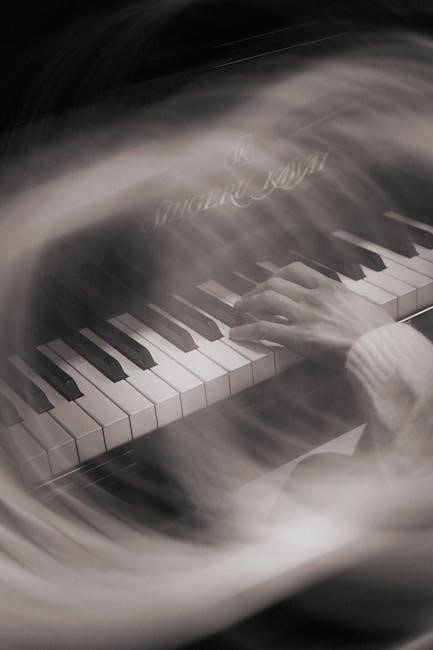
Historical Context of the Concerto
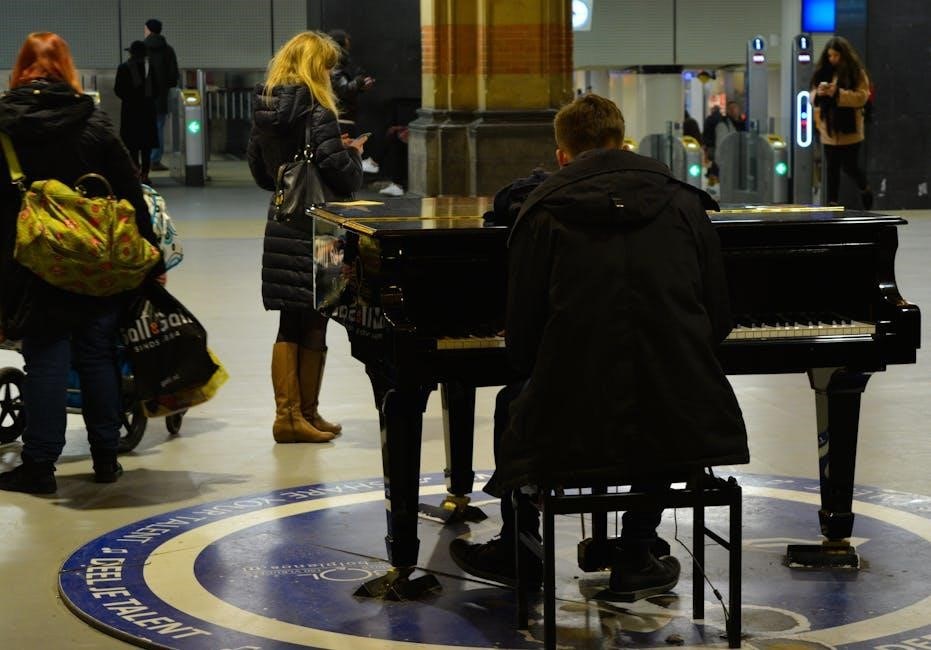
Rachmaninoff’s Piano Concerto No. 2 premiered in 1901 in Moscow‚ marking a triumphant return for the composer after personal struggles. Its success solidified his reputation‚ and the concerto remains a cornerstone of classical music‚ with its sheet music widely sought after for study and performance.
2.1. Premiere and Reception
Rachmaninoff’s Piano Concerto No. 2 premiered on November 9‚ 1901‚ in Moscow‚ with the composer himself as the soloist. The performance was a resounding success‚ earning widespread acclaim from both the audience and critics. This triumph marked a significant turning point in Rachmaninoff’s career‚ restoring his confidence after earlier struggles. The concerto’s emotional depth and technical brilliance captivated listeners‚ solidifying its place as one of the most beloved works in classical music. The second movement‚ in particular‚ became a favorite‚ celebrated for its lyrical beauty and expressive power. Its enduring popularity has led to numerous arrangements and adaptations‚ including sheet music downloads in PDF format for pianists worldwide.
2.2. Rachmaninoff’s Role as Composer and Pianist
Sergei Rachmaninoff was a virtuosic pianist and a masterful composer‚ and his Piano Concerto No. 2 exemplifies this dual talent. As both the composer and the performer during its premiere‚ he brought unparalleled depth to the work. His ability to weave intricate melodies with technical challenges showcased his prowess as a pianist. The second movement‚ with its soaring themes‚ reflects Rachmaninoff’s expressive command of the instrument. His role as both creator and interpreter allowed him to craft a concerto that remains a benchmark for pianists. Today‚ sheet music for the second movement is widely available in PDF format‚ enabling pianists to explore and perform this iconic piece‚ continuing Rachmaninoff’s legacy as a titan of classical music.

Musical Structure of the Second Movement
The second movement‚ marked Adagio sostenuto‚ is in E major‚ featuring a lyrical and emotionally profound structure. Its thematic development and harmonic richness create a captivating musical experience‚ with sheet music widely available for study and performance.
3.1. Adagio Sostenuto: Tempo and Character
The second movement of Rachmaninoff’s Piano Concerto No. 2 is marked Adagio sostenuto‚ characterized by a slow‚ introspective tempo and deeply emotional character. The movement unfolds in E major‚ creating a sense of lyrical elegance and poetic depth. Its melodic richness and harmonic complexity make it a standout piece‚ with the piano part showcasing Rachmaninoff’s mastery of expressive phrasing. The sheet music‚ available in PDF format‚ highlights the movement’s intricate details‚ allowing pianists to explore its emotional nuances. This movement is widely regarded as one of the most beautiful and technically challenging in the piano repertoire‚ making it a favorite for both performers and audiences.
3.2. Key Signatures and Modulations
The second movement of Rachmaninoff’s Piano Concerto No. 2 is written in the key of E major‚ creating a serene and expressive atmosphere. The movement features intricate modulations‚ transitioning seamlessly between related keys to enhance emotional depth. Chromatic passages and unexpected harmonic shifts add complexity‚ showcasing Rachmaninoff’s mastery of tonal exploration. The sheet music highlights these key signatures and modulations‚ essential for pianists to interpret the movement’s dramatic contrasts and lyrical flow. The interplay between the solo piano and orchestra is further enriched by these harmonic nuances‚ making the piece a landmark of late Romantic music.
3.3. Thematic Development
The second movement of Rachmaninoff’s Piano Concerto No. 2 is renowned for its rich thematic development. The movement introduces a hauntingly beautiful melody in the orchestra‚ which is later taken up by the piano‚ creating a dialogue of emotional intensity. This main theme undergoes subtle transformations‚ evolving through dynamic contrasts and harmonic shifts. The sheet music reveals how Rachmaninoff masterfully weaves this theme throughout the movement‚ maintaining coherence while exploring its expressive potential. The interplay between the soloist and orchestra highlights the thematic material‚ culminating in a deeply moving experience. The availability of sheet music in PDF format allows pianists to study and perform this iconic piece‚ capturing its dramatic and lyrical essence.
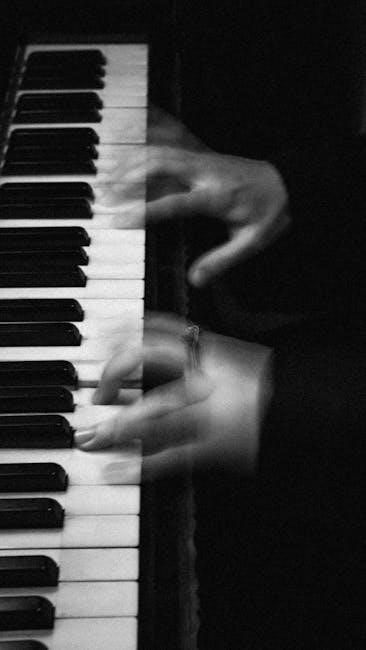
Sheet Music Availability and Formats
Sheet music for Rachmaninoff’s Piano Concerto No. 2‚ second movement‚ is widely available in PDF format from sources like Sheet Music Direct and Hal Leonard‚ offering various arrangements.
4.1. Sources for PDF Downloads
Several reputable platforms offer Rachmaninoff’s Piano Concerto No. 2‚ second movement‚ in PDF format. Websites like Sheet Music Direct provide high-quality downloads for piano solo‚ priced at $5.99. Additionally‚ Hal Leonard offers transposable‚ interactive scores‚ while MuseScore and IMSLP feature free arrangements‚ including reductions for two pianos. These sources cater to both professionals and beginners‚ ensuring accessibility for all skill levels. The availability of these PDFs makes it easy for pianists to download and print the sheet music instantly‚ facilitating practice and performance.
4.2. Features of Digital Sheet Music
Digital sheet music for Rachmaninoff’s Piano Concerto No. 2‚ second movement‚ offers numerous advantages. High-quality PDF files ensure crisp notation‚ while interactive features like playback‚ metronome‚ and transposition enhance practice. Many platforms‚ such as Sheet Music Direct and MuseScore‚ provide instant downloads‚ allowing pianists to access the music effortlessly. Additionally‚ digital scores often include annotations and performance notes‚ aiding interpretation. The ability to transpose the piece into different keys further caters to individual preferences. These features make digital sheet music a versatile and convenient choice for musicians of all levels‚ facilitating both learning and performance.
4.3. Free vs. Paid Versions
When seeking sheet music for Rachmaninoff’s Piano Concerto No. 2‚ second movement‚ musicians can choose between free and paid versions. Free versions‚ often found on platforms like MuseScore or IMSLP‚ provide basic notation but may lack quality or legality. Paid versions‚ available on sites like Sheet Music Direct‚ offer high-quality PDFs‚ accurate notation‚ and additional features such as interactive playback and transposition. While free options are budget-friendly‚ they may not include all movements or may be unauthorized copies. Paid versions ensure legitimacy‚ better formatting‚ and support for composers or publishers. For serious practice or performance‚ investing in a paid version is recommended for its reliability and enhanced features.
Popular Arrangements and Editions
Rachmaninoff’s Piano Concerto No. 2‚ second movement‚ is available in various arrangements‚ including piano solo‚ orchestral reductions‚ and beginner-friendly editions. These versions cater to different skill levels and preferences.
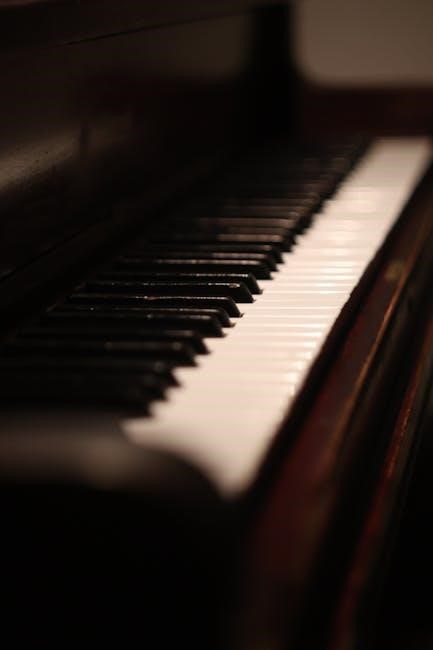
5.1. Piano Solo Arrangements
Piano solo arrangements of Rachmaninoff’s Piano Concerto No. 2‚ second movement‚ are widely popular among pianists. These arrangements capture the essence of the original concerto‚ offering a challenging yet rewarding experience for performers. Many arrangements are available in digital formats‚ including PDF downloads‚ which provide high-quality scores for practice and performance. Some versions are transposed into different keys to suit various skill levels‚ making the piece accessible to a broader audience. Additionally‚ interactive sheet music allows for tempo adjustments and accompaniment tracks‚ enhancing the learning process. These arrangements maintain the emotional depth and technical complexity of Rachmaninoff’s masterpiece‚ ensuring its timeless appeal continues to inspire pianists worldwide.
5.2. Orchestral Reductions for Two Pianos
Orchestral reductions for two pianos are a popular way to experience Rachmaninoff’s Piano Concerto No. 2‚ second movement. These arrangements faithfully capture the orchestral texture‚ allowing two pianists to collaborate and recreate the concerto’s grandeur. Available in PDF formats from sources like Sheet Music Direct and Hal Leonard‚ these reductions maintain the original’s emotional depth and technical complexity; They are ideal for practice‚ performance‚ and study‚ offering a unique opportunity to explore the interplay between piano and orchestra in a condensed form. These arrangements are particularly valuable for pianists seeking to refine their ensemble skills while enjoying the concerto’s timeless beauty.
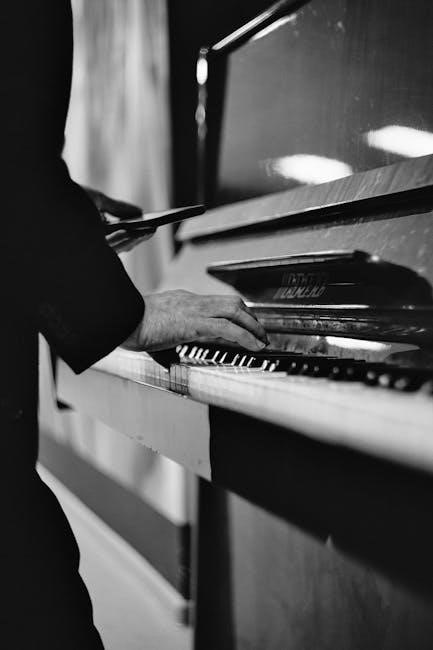
Performance Considerations
Performing Rachmaninoff’s Piano Concerto No. 2‚ second movement‚ demands technical precision and emotional depth. Pianists must master intricate passages while conveying the movement’s lyrical and expressive qualities‚ ensuring a captivating interpretation.
6.1. Technical Challenges
The second movement of Rachmaninoff’s Piano Concerto No. 2 presents significant technical challenges. Pianists must navigate intricate arpeggios‚ complex chord progressions‚ and demanding octave techniques. The piece requires exceptional finger dexterity‚ strength‚ and precise control‚ particularly in the upper registers. Additionally‚ the expansive hand spans and rapid passages demand careful practice and a strong technical foundation. Musicians often struggle with maintaining clarity and balance in the dense textures‚ especially during the climactic moments. To master this movement‚ pianists need to focus on slow‚ deliberate practice‚ gradually increasing tempo while preserving musicality. A metronome and meticulous finger exercises are essential tools in overcoming these challenges effectively.
6.2. Interpretive Insights
The second movement of Rachmaninoff’s Piano Concerto No. 2 is renowned for its emotional depth and lyrical beauty‚ offering pianists a canvas for expressive interpretation. To convey the movement’s passion and vulnerability‚ pianists must emphasize dynamic contrasts‚ nuanced phrasing‚ and subtle rubato. The melancholic melody in the opening should be played with tenderness‚ while the climactic sections demand powerful yet controlled execution. Balancing the orchestral accompaniment while maintaining clarity in the piano part is essential. Pianists are encouraged to explore the rich harmonic textures and express the underlying longing inherent in the music. Effective use of pedaling can enhance the movement’s resonant‚ singing quality‚ creating a deeply moving experience for both performer and audience.
6.3. Practice Tips
Mastering the second movement of Rachmaninoff’s Piano Concerto No. 2 requires focused practice. Begin by practicing slowly to ensure technical accuracy and emotional expression. Break the movement into smaller sections‚ such as the opening melody or the climactic buildup‚ and gradually combine them. Pay attention to dynamics‚ as the movement’s dramatic contrasts are key to its impact. Work on pedaling techniques to achieve the desired tonal clarity and sustain. Record yourself to identify areas for improvement. Additionally‚ study recordings by renowned pianists to gain interpretive insights. Regularly practice with a metronome to maintain precise timing‚ especially in the movement’s intricate passages. Seek guidance from a teacher or experienced pianist to refine your interpretation and address technical challenges.

Cultural and Musical Impact
Rachmaninoff’s Piano Concerto No. 2‚ especially its second movement‚ holds a revered place in classical music‚ frequently featured in films‚ media‚ and popular culture‚ inspiring countless arrangements and interpretations.
7.1. Use in Media and Pop Culture
Rachmaninoff’s Piano Concerto No. 2‚ particularly its second movement‚ has become a staple in media and pop culture. Its hauntingly beautiful melodies have been featured in numerous films‚ television shows‚ and even popular songs. The piece’s emotional depth and universal appeal make it a favorite for soundtracks‚ often evoking powerful emotions in audiences. Additionally‚ its themes have been adapted and sampled in various genres of music‚ further cementing its cultural significance. The availability of sheet music in PDF format has also allowed for creative arrangements‚ making it accessible for use in diverse musical contexts. This widespread use highlights the concerto’s enduring influence on modern culture and media.
7.2. Public Perception and Favorites
Rachmaninoff’s Piano Concerto No. 2‚ particularly its second movement‚ holds a special place in public perception as one of the most beloved classical pieces. Its emotional depth and lyrical beauty have captivated audiences worldwide‚ making it a consistent favorite in classical music polls. The concerto’s timeless appeal lies in its ability to evoke profound emotions‚ resonating with listeners of all backgrounds. Its popularity is further evident in its frequent inclusion in “greatest classical works” lists and its widespread recognition as a masterpiece of Romantic-era music. The availability of sheet music in PDF format has also made it accessible to pianists and enthusiasts‚ ensuring its enduring presence in both professional and amateur repertoires.

Resources for Musicians
Sheet Music Direct‚ Musicnotes‚ and IMSLP offer high-quality PDF and MIDI downloads of Rachmaninoff’s Piano Concerto No. 2‚ including the second movement‚ for pianists of all levels.
8.1. Recommended Websites for Download
For accessing Rachmaninoff’s Piano Concerto No. 2‚ second movement sheet music in PDF format‚ several reputable websites are recommended. Sheet Music Direct offers a wide range of scores‚ including the concerto‚ with options for instant downloads. Musicnotes provides high-quality‚ interactive sheet music‚ allowing for transposition to suit individual needs. Additionally‚ IMSLP‚ a vast public domain sheet music archive‚ offers free downloads of the concerto‚ including the second movement. These platforms cater to both professional musicians and hobbyists‚ ensuring accessibility and variety. Many sites also feature user-friendly interfaces and curated collections‚ making it easy to find and download the desired piece. Free and paid versions are available‚ depending on the site and arrangement type.
8.2. Scores and Parts Availability
The second movement of Rachmaninoff’s Piano Concerto No. 2 is widely available in various formats. Piano solo scores can be downloaded from platforms like Sheet Music Direct and Musicnotes‚ offering both digital and printable versions. Orchestral parts‚ including the full score and individual instrument sections‚ are accessible through sites like IMSLP and major music publishers. Many arrangements cater to different skill levels‚ from beginner-friendly versions to advanced transcriptions. Additionally‚ some websites provide orchestral reductions for two pianos‚ making it easier for pianists to practice collaboratively. These resources ensure that musicians can find the necessary materials to perform and study this iconic piece effectively‚ regardless of their role or preference.
8.3. Editions for Beginners
For aspiring pianists‚ beginner-friendly editions of Rachmaninoff’s Piano Concerto No. 2‚ second movement‚ are available. These simplified arrangements maintain the piece’s essence while adapting complex passages for easier execution. Some editions offer interactive sheet music‚ allowing transposition to suit individual skill levels. Platforms like Sheet Music Direct and Virtual Sheet Music provide these adaptations‚ ensuring accessibility for learners. Additionally‚ certain versions focus on the piano solo part‚ omitting orchestral elements to help beginners concentrate on the melody and harmony. These editions are invaluable for those seeking to master the concerto’s emotional depth and technical challenges in a gradual and manageable way.

Rachmaninoff’s Piano Concerto No. 2‚ second movement‚ remains an iconic piece‚ celebrated for its emotional depth and melodic beauty. Its sheet music is widely accessible‚ ensuring its timeless appeal to pianists and music lovers alike.
9.1. Final Thoughts on the Second Movement
Rachmaninoff’s second movement of Piano Concerto No. 2 is a masterwork of emotional resonance. Its availability in PDF sheet music formats‚ both free and paid‚ ensures accessibility for pianists of all levels. The movement’s Adagio sostenuto tempo and rich harmonies continue to captivate audiences‚ making it a cornerstone of classical music. Its frequent use in media and popularity in polls underscore its timeless appeal. Pianists seeking to interpret this piece should delve deeply into its nuances‚ balancing technical precision with heartfelt expression. The second movement remains a testament to Rachmaninoff’s genius‚ offering a profound musical experience for both performers and listeners.
9.2. Encouragement for Aspiring Pianists
Aspiring pianists are encouraged to explore Rachmaninoff’s second movement‚ as its sheet music is readily available in PDF formats. While the piece presents technical challenges‚ its emotional depth offers immense rewards. Beginners can start with simplified arrangements‚ gradually approaching the original score. Practice tips‚ such as focusing on phrasing and dynamic control‚ can help master its nuances. The availability of free and paid sheet music ensures accessibility for all skill levels. Embrace the journey of learning this iconic piece‚ as it embodies the essence of musical expression and technical mastery‚ inspiring growth and passion for classical music.
